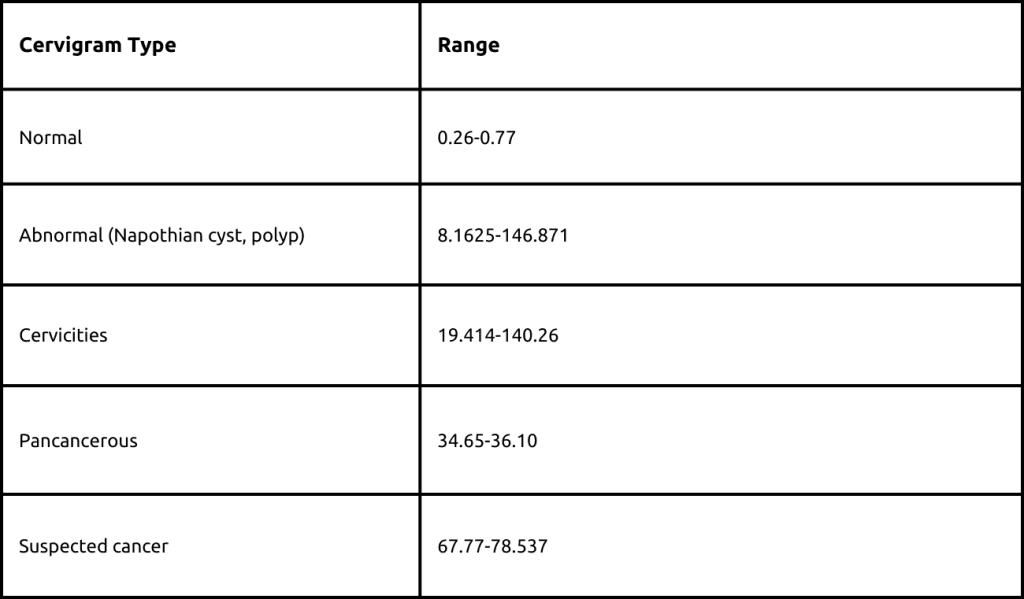Earth Mover’s Distance-Based Tool for Rapid Screening of Cervical Cancer Using Cervigrams
Read the Magazine in PDF
Abstract
Cervical cancer is a pervasive global health issue, causing widespread mortality. This article highlights the urgent need for enhanced screening and diagnosis. The prevalence of myths and misconceptions around the disease further exacerbates the challenge. Current screening methods are resource-intensive, time-consuming, and suffer from a shortage of pathologists. To combat this, an accurate and robust diagnostic tool is proposed, with potential benefits including early detection even in resource-constrained communities, reduced disease burden, cost savings, and improved health equity. The scale for cervix normality/abnormality achieved an accuracy of 77%. This innovative approach holds promise for improving cervical cancer outcomes and saving lives worldwide.
Introduction
Cervical cancer is a pressing public health concern that continues to afflict women worldwide, especially in regions with limited access to healthcare resources. Early detection remains crucial for effective treatment and improved outcomes in the fight against this devastating disease.
Cervical Cancer in the Global Context
Cervical cancer ranks as the fourth most common cancer globally, underscoring its widespread impact on women’s health.
Every day, approximately 185 women lose their lives to this disease, highlighting its devastating toll on families and communities. Disturbingly, this equates to approximately eight women succumbing to cervical cancer every hour. The grim statistics become even more unsettling when we realize that a woman dies from cervical cancer every eight minutes.
This grim reality underscores the dire need for more effective screening, diagnosis, and treatment options to combat cervical cancer.
The Primary Problem: Misconceptions and Myths
A significant barrier to the fight against cervical cancer is the prevalence of myths and misconceptions surrounding the disease.
Lack of awareness and misinformation often lead women to neglect cervical cancer screening and early detection, which are vital in preventing its progression.
Cervical Cancer Screening and Challenges
Presently, cervical cancer screening primarily involves methods like the PAP test and colposcopy. However, these approaches present a series of challenges:
- Time-consuming and Resource-Intensive: Identifying and diagnosing coloscopic cervigrams is a laborious and time-consuming task that requires a considerable amount of expertise and resources.
- Lack of Pathologists: A severe shortage of pathologists further compounds the issue, leading to misdiagnoses and missed diagnoses.
- Inadequate Screening: Cervical cancer screening is not conducted at an adequate level, leaving many women vulnerable to the disease’s progression.
Proposed Solution: A New Diagnostic Tool
To address these challenges, there is a critical need for an accurate and robust diagnostic tool. This tool has the potential to reduce the time and errors associated with cervical cancer diagnosis and facilitate screening at the community level, even in settings with limited resources.
Methodology
Target Population
- Inclusion criteria: Married women over 18 years who provide written informed consent.
- Exclusion criteria: Pregnant women, those who have had a hysterectomy, and women who do not provide written informed consent.
- Software Platform for Development and Validation: Rstudio, Linux, MySQL
Study Area:
Batra Hospital & Medical Research Centre, New Delhi, Delhi State Cancer Institute, New Delhi, and extended communities.
Our Thought: Development of a robust image analysis tool which is Data Collection
- Cervigrams of study participants were obtained using EVA digital colposcopes for computational analysis.
- Clinico-epidemiological data were collected through questionnaires.
Earth mover Distance
Based upon the similarity and dissimilarities in the image obtained by the colposcope numerical are obtained. The lower numbers point to normal cervix and as the numbers go up indicate abnormal cervix. The highest numbers point to suspected cancer.
On-The Oncometer
The measurement scale for cervix normality abnormality

Measuring Cervix Normality/Abnormality
An accurate diagnostic tool should be judged by its ability to distinguish between normal and abnormal cervix conditions. The measurement scale for cervix normality/abnormality achieves the following results:
- Accuracy: 77% (Based on EMD results scale)
- Sensitivity: 83.56%
- Specificity: 59.25
Scalability
The proposed solution is highly scalable, enabling its implementation across various healthcare settings. The outcomes achieved so far and those expected in the future include:
- Early detection and improved outcomes, even in communities with limited healthcare infrastructure,
- Reduction in the disease burden through effective screening and diagnosis
- Implementation of preventive care measures
- Cost savings in healthcare delivery.
- Efficient resource allocation for cervical cancer care
- Targeted interventions to reach vulnerable populations.
- Advancing health equity by ensuring all women have access to cervical cancer screening
- Quality improvement in the diagnostic process.
- Empowering patients to take charge of their health by promoting awareness and early screening
Conclusion
Cervical cancer remains a significant global health concern, and the proposed diagnostic tool offers a promising solution to address the challenges associated with its early detection and diagnosis. With the potential to save lives, reduce healthcare costs, and improve patient outcomes, this tool brings hope in the fight against cervical cancer.




